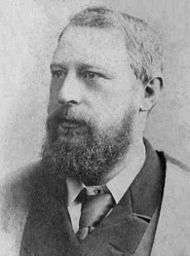Charles Bagge Plowright
| Charles Bagge Plowright | |
|---|---|
 | |
| Born |
3 April 1849 King's Lynn, Norfolk, England |
| Died |
24 April 1910 (aged 61) North Wootton, Norfolk, England |
| Nationality | United Kingdom |
| Occupation | Surgeon |
| Known for | mycology |
Charles Bagge Plowright (3 April 1849 – 24 April 1910) was a British doctor and mycologist.
Plowright trained as a doctor at the West Norfolk and Lynn Hospital, eventually becoming a surgeon there. He was also a Medical Officer for Health for many years in Freebridge Lynn, and was the Hunterian Professor of Comparative Anatomy and Physiology at the Royal College of Surgeons from 1890 to 1894. While a professor he gave lectures on ergot and fungi in the human body which were noted in the British Journal of Medicine.[1]
Plowright's most significant contributions were in mycology. In 1872 he published a list of 800 Norfolk fungi in the Transactions of the Norfolk and Norwich Naturalists' Society and was elected an honorary member. Starting in 1873, Plowright published a series of fasciculi (pamphlets intended to be collected into a book) titled Sphaeriacei Britannici describing members of the fungal genus Sphaeria (species modernly placed in Pseudovalsa, Macrospora, Homostegia, and others). With his collaborator William Phillips, Plowright published a series of papers titled New and Rare British Fungi (1871–1884) which described almost 300 new species. Plowright contributed to The Gardeners' Chronicle for over thirty years, writing principally on fungal diseases of plants; he was an early advocate in England of the use of Bordeaux mixture. Early in his career he made a special collection of Pyrenomycetae (now Sordariomycetes) and published several papers on them; he later moved on to the Uredinaceae, in 1889 publishing A Monograph of the British Uredinaea and Ustilaginaea. He was one of the early organizers of the British Mycological Society and served as president in 1898–9.
Plowright had an interest in archaeology and published a number of articles on the subject, including several works on woad.[2]
Plowright also was active in his local community, serving as a local magistrate, director and vice-chairman of a local girl's high school, and governor of the Lynn Grammar School.[3]
Family
Plowright married Mary Jane Lovie Robb, daughter of an Edinburgh merchant, and they had two children: Edith Mary (b. 1875) and Charles Tertius Maclean Plowright (1879–1935). Charles was a surgeon and became a captain in the Royal Army Medical Corps.[4] Edith Mary married Thomas Petch, also a mycologist, in 1908.[5]
References
| Wikisource has original works written by or about: Charles Bagge Plowright |
- ↑ CHARLES BAGGE PLOWRIGHT M.D.: A VICTORIAN POLYMATH. Australian Postal History & Social Philately
- ↑ "Charles Bagge Plowright, M.D., F.R.C.S. Hon., J.P". Transactions of the British Mycological Society. 3: 231–2. 1910. doi:10.1016/S0007-1536(07)80042-8.
- ↑ "Charles Bagge Plowright, M.d". British Medical Journal. 1 (2575): 1149. 1910. doi:10.1136/bmj.1.2575.1149.
- ↑ Charles Tertius MacLean Plowright. thepeerage.com
- ↑ Pharmaceutical Journal. 80: 45. January 1908. Missing or empty
|title=(help) - ↑ IPNI. Plowr.